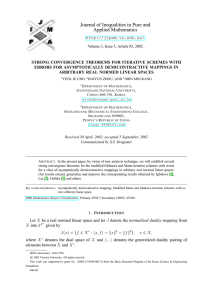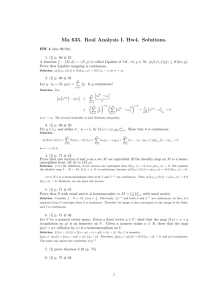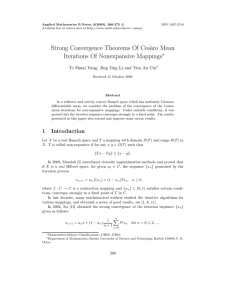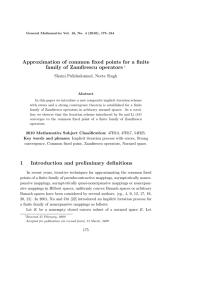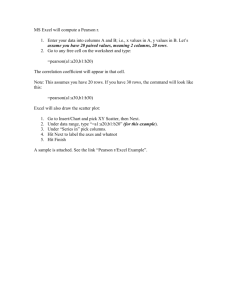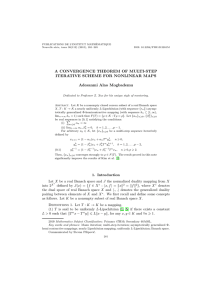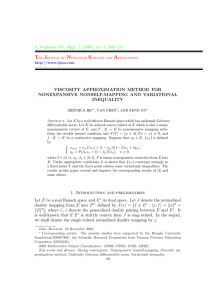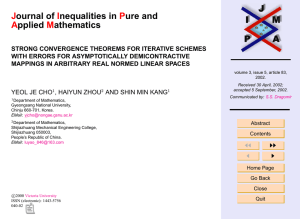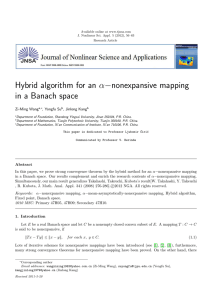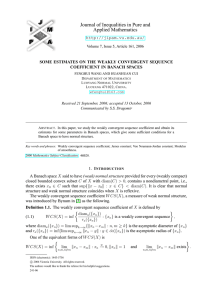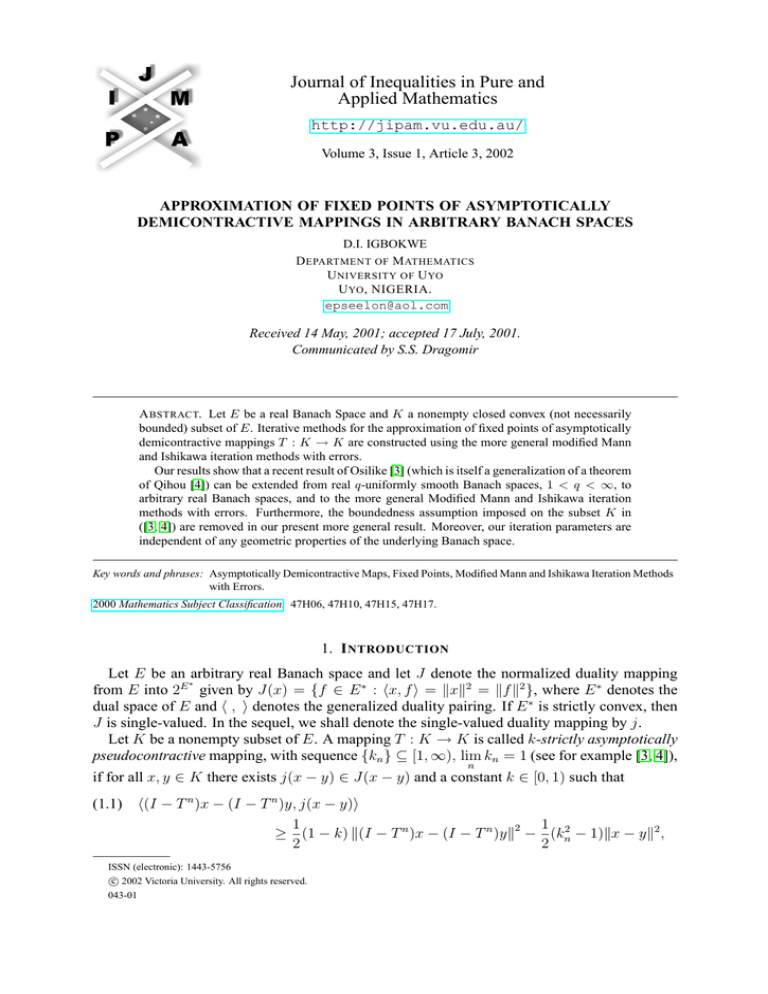
Journal of Inequalities in Pure and
Applied Mathematics
http://jipam.vu.edu.au/
Volume 3, Issue 1, Article 3, 2002
APPROXIMATION OF FIXED POINTS OF ASYMPTOTICALLY
DEMICONTRACTIVE MAPPINGS IN ARBITRARY BANACH SPACES
D.I. IGBOKWE
D EPARTMENT OF M ATHEMATICS
U NIVERSITY OF U YO
U YO , NIGERIA.
epseelon@aol.com
Received 14 May, 2001; accepted 17 July, 2001.
Communicated by S.S. Dragomir
A BSTRACT. Let E be a real Banach Space and K a nonempty closed convex (not necessarily
bounded) subset of E. Iterative methods for the approximation of fixed points of asymptotically
demicontractive mappings T : K → K are constructed using the more general modified Mann
and Ishikawa iteration methods with errors.
Our results show that a recent result of Osilike [3] (which is itself a generalization of a theorem
of Qihou [4]) can be extended from real q-uniformly smooth Banach spaces, 1 < q < ∞, to
arbitrary real Banach spaces, and to the more general Modified Mann and Ishikawa iteration
methods with errors. Furthermore, the boundedness assumption imposed on the subset K in
([3, 4]) are removed in our present more general result. Moreover, our iteration parameters are
independent of any geometric properties of the underlying Banach space.
Key words and phrases: Asymptotically Demicontractive Maps, Fixed Points, Modified Mann and Ishikawa Iteration Methods
with Errors.
2000 Mathematics Subject Classification. 47H06, 47H10, 47H15, 47H17.
1. I NTRODUCTION
Let E be an arbitrary real Banach space and let J denote the normalized duality mapping
∗
from E into 2E given by J(x) = {f ∈ E ∗ : hx, f i = kxk2 = kf k2 }, where E ∗ denotes the
dual space of E and h , i denotes the generalized duality pairing. If E ∗ is strictly convex, then
J is single-valued. In the sequel, we shall denote the single-valued duality mapping by j.
Let K be a nonempty subset of E. A mapping T : K → K is called k-strictly asymptotically
pseudocontractive mapping, with sequence {kn } ⊆ [1, ∞), lim kn = 1 (see for example [3, 4]),
n
if for all x, y ∈ K there exists j(x − y) ∈ J(x − y) and a constant k ∈ [0, 1) such that
(1.1)
h(I − T n )x − (I − T n )y, j(x − y)i
1
1
≥ (1 − k) k(I − T n )x − (I − T n )yk2 − (kn2 − 1)kx − yk2 ,
2
2
ISSN (electronic): 1443-5756
c 2002 Victoria University. All rights reserved.
043-01
2
D.I. I GBOKWE
for all n ∈ N. T is called an asymptotically demicontractive mapping with sequence kn ⊆
[0, ∞), lim kn = 1 (see for example [3, 4]) if F (T ) = {x ∈ K : T x = x} 6= ∅ and for all
n
x ∈ K and x∗ ∈ F (T ), there exists k ∈ [0, 1) and j(x − x∗ ) ∈ J(x − x∗ ) such that
1
1
hx − T n x, j(x − x∗ )i ≥ (1 − k)kx − T n xk2 − (kn2 − 1)kx − x∗ k2
2
2
for all n ∈ N. Furthermore, T is uniformly L-Lipschitzian, if there exists a constant L > 0,
such that
(1.2)
(1.3)
kT n x − T n yk ≤ Lkx − yk,
for all x , y ∈ K and n ∈ N.
It is clear that a k-strictly asymptotically pseudocontrative mapping with a nonempty fixed
point set F (T ) is asymptotically demicontrative. The classes of k-strictly asymptotically pseudocontractive and asymptotically demicontractive maps were first introduced in Hilbert spaces
by Qihou [4]. In a Hilbert space, j is the identity and it is shown in [3] that (1.1) and (1.2) are
respectively equivalent to the inequalities:
(1.4)
kT n x − T n yk ≤ kn2 kx − yk2 + kk(I − T n )x − (I − T n )yk2
and
(1.5)
kT n x − T n yk2 ≤ kn2 kx − yk2 + kx − T n xk2
which are the inequalities considered by Qihou [4].
In [4], Qihou using the modified Mann iteration method introduced by Schu [5], proved convergence theorem for the iterative approximation of fixed points of k-strictly asymptotically
pseudocontractive mappings and asymptotically demicontractive mappings in Hilbert spaces.
Recently, Osilike [3], extended the theorems of Qihou [4] concerning the iterative approximation of fixed points of k- strictly asymptotically demicontractive mappings from Hilbert spaces
to much more general real q-uniformly smooth Banach spaces, 1 < q < ∞, and to the much
more general modified Ishikawa iteration method. More precisely, he proved the following:
Theorem 1.1. (Osilike [3, p. 1296]): Let q > 1 and let E be a real q-uniformly smooth Banach
space. Let K be a closed convex and bounded subset of E and T : K → K a completely
continuous uniformly L-Lipschitzian
asymptotically demicontractive mapping with a sequence
P∞
2
kn ⊆ [1, ∞) satisfying n=1 (kn − 1) < ∞. Let {αn } and {βn } be real sequences satisfying
the conditions.
(i) 0 ≤ αn , βn ≤ 1, n ≥ 1;
(ii) 0 <∈≤ cq αnq−1 (1 + Lβn )q ≤ 21 {q(1 − k)(1 + L)−(q−2) }− ∈, for all n ≥ 1 and for some
∈>
P 0; and
(iii) ∞
n=0 βn < ∞.
Then the sequence {xn } generated from an arbitrary x1 ∈ K by
yn = (1 − βn )xn + βn T n xn , n ≥ 1,
xn+1 = (1 − αn )xn + αn T n yn , n ≥ 1
converges strongly to a fixed point of T .
In Theorem 1.1, cq is a constant appearing in an inequality which characterizes q-uniformly
smooth Banach spaces. In Hilbert spaces, q = 2, cq = 1 and with βn = 0 ∀n, Theorems 1 and
2 of Qihou [4] follow from Theorem 1.1 (see Remark 2 of [3]).
It is our purpose in this paper to extend Theorem 1.1 from real q-uniformly smooth Banach spaces to arbitrary real Banach spaces using the more general modified Ishikawa iteration
J. Inequal. Pure and Appl. Math., 3(1) Art. 3, 2002
http://jipam.vu.edu.au/
A PPROXIMATION
OF
F IXED P OINTS OF A SYMPTOTICALLY D EMICONTRACTIVE M APPINGS
3
method with errors in the sense of Xu [7] given by
(1.6)
yn = an xn + bn T n xn + cn un , n ≥ 1,
xn+1 = a0n xn + b0n T n yn + c0n vn , n ≥ 1,
where {an }, {bn }, {cn }, {a0n }, {b0n }, {c0n } are real sequences in [0, 1]. an + bn + cn = 1 =
a0n + b0n + c0n , {un } and {vn } are bounded sequences in K. If we set bn = cn = 0 in (1.6) we
obtain the modified Mann iteration method with errors in the sense of Xu [7] given by
(1.7)
xn+1 = a0n xn + b0n T n xn + c0n vn , n ≥ 1.
2. M AIN R ESULTS
In the sequel, we shall need the following:
Lemma 2.1. Let E be a normed space, and K a nonempty convex subset of E. Let T : K →
K be uniformly L-Lipschitzian mapping and let {an }, {bn }, {cn }, {a0n }, {b0n } and {c0n } be
sequences in [0, 1] with an + bn + cn = a0n + b0n + c0n = 1. Let {un }, {vn } be bounded sequences
in K. For arbitrary x1 ∈ K, generate the sequence {xn } by
y n = an x n + b n T n x n + c n u n , n ≥ 1
xn+1 = a0n xn + b0n T n yn + c0n vn , n ≥ 0.
Then
kxn − T xn k ≤ kxn − T n xn k + L(1 + L)2 kxn+1 − T n−1 xn−1 k
+ L(1 + L)c0n−1 kvn−1 − xn−1 k + L2 (1 + L)cn−1 kun−1 − xn k
(2.1)
+ Lc0n−1 kxn−1 − T n−1 xn−1 k.
Proof. Set λn = kxn − T n xn k. Then
kxn − T xn k ≤ kxn − T n xn k + LkT n−1 xn − xn k
≤ λn + L2 kxn − xn−1 k + LkT n−1 xn−1 − xn k
= λn + L2 ka0n−1 xn + b0n−1 T n−1 yn−1 + c0n−1 vn−1 − xn−1 k
+ Lka0n−1 xn−1 + b0n−1 T n−1 yn−1 + c0n−1 vn−1 − T n−1 xn−1 k
= λn + L2 kb0n−1 (T n−1 yn−1 − xn−1 ) + c0n−1 (vn−1 − xn−1 )k
+ Lka0n−1 (xn−1 − T n−1 xn−1 ) + b0n−1 (T n−1 yn−1 − T n−1 xn−1 )
+ c0n−1 (vn−1 − T n−1 xn−1 )k
≤ λn + L2 kT n−1 yn−1 − xn−1 k + L2 c0n−1 kvn−1 − xn−1 k
+ Lkxn−1 − T n−1 xn−1 k + L2 kyn−1 − xn−1 k + Lc0n−1 kvn−1 − xn−1 k
+ Lc0n−1 kxn−1 − T n−1 xn−1 k
= λn + Lλn−1 + L(1 + L)c0n−1 kvn−1 − xn−1 k + L2 kT n−1 yn−1 − xn−1 k
+ L2 kyn−1 − xn−1 k + Lc0n−1 kxn−1 − T n−1 xn−1 )k
J. Inequal. Pure and Appl. Math., 3(1) Art. 3, 2002
http://jipam.vu.edu.au/
4
D.I. I GBOKWE
≤ λn + 2Lλn−1 + L(1 + L)c0n−1 kvn−1 − xn−1 k + L2 (1 + L)kyn−1 − xn−1 k
+ L2 kT n−1 xn−1 − xn−1 k + Lc0n−1 kxn−1 − T n−1 xn−1 )k
= λn + L(1 + L)λn−1 + L(1 + L)c0n−1 kvn−1 − xn−1 k
+ L2 (1 + L)kbn−1 (T n−1 xn−1 − xn−1 ) + cn−1 (un−1 − xn−1 )k
+ Lc0n−1 kxn−1 − T n−1 xn−1 k
≤ λn + L(L2 + 2L + 1)λn−1 + L(1 + L)c0n−1 kvn−1 − xn−1 k
+ L2 (1 + L)cn−1 kun−1 − xn−1 k + Lc0n−1 kxn−1 − T n−1 xn−1 k,
completing the proof of Lemma 1.
Lemma 2.2. Let {an }, {bn } and {δn } be sequences of nonnegative real numbers satisfying
(2.2)
an+1 ≤ (1 + δn )an + bn , n ≥ 1.
P∞
P∞
If n=1 δn < ∞ and n=1 bn < ∞ then lim an exists. If in addition {an } has a subsequence
n→∞
which converges strongly to zero then lim an = 0.
n→∞
Proof. Observe that
an+1 ≤ (1 + δn )an + bn
≤ (1 + δn )[(1 + δn−1 )an−1 + bn−1 ] + bn
n
n
n
Y
Y
X
≤ ... ≤
(1 + δj )a1 + (1 + δj )
bj
≤ ... ≤
j=1
∞
Y
j=1
∞
Y
j=1
∞
X
j=1
j=1
j=1
(1 + δj )a1 +
(1 + δj )
bj < ∞.
Hence {an } is bounded. Let M > 0 be such that an ≤ M, n ≥ 1. Then
an+1 ≤ (1 + δn )an + bn ≤ an + M δn + bn = an + σn
where σn = M δn + bn . It now follows from Lemma 2.1 of ([6, p. 303]) that lim an exists.
n
Consequently, if {an } has a subsequence which converges strongly to zero then lim an = 0
n
completing the proof of Lemma 2.2.
Lemma 2.3. Let E be a real Banach space and K a nonempty convex subset of E. Let T :
K → K be uniformly L-Lipschitzian asymptotically
demicontractive mapping with a sequence
P
2
−
1) < ∞. Let {an }, {bn }, {cn },
{kn } ⊆ [1, ∞), such that lim kn = 1, and ∞
(k
n=1 n
n
{a0n } , {b0n } , {c0n } be real sequences in [0, 1] satisfying:
0
0
0
(i) a
n + b n + c n = 1 = an + b n + c n ,
P
∞
(ii) Pn=1 b0n = ∞, P
P∞
P∞
∞
0 2
0
(iii) ∞
n=1 (bn ) < ∞,
n=1 cn < ∞,
n=1 bn < ∞, and
n=1 cn < ∞.
Let {un } and {vn } be bounded sequences in K and let {xn } be the sequence generated from
an arbitrary x1 ∈ K by
yn = an xn + bn T n xn + cn un , n ≥ 1,
xn+1 = a0n + b0n T n yn + c0n vn , n ≥ 1,
then lim inf kxn − T xn k = 0.
n
J. Inequal. Pure and Appl. Math., 3(1) Art. 3, 2002
http://jipam.vu.edu.au/
A PPROXIMATION
OF
F IXED P OINTS OF A SYMPTOTICALLY D EMICONTRACTIVE M APPINGS
5
Proof. It is now well-known (see e.g. [1]) that for all x, y ∈ E, there exists j(x + y) ∈ J(x + y)
such that
(2.3)
kx + yk2 ≤ kxk2 + 2hy, j(x + y)i.
Let x∗ ∈ F (T ) and let M > 0 be such that kun − x∗ k ≤ M, kvn − x∗ k ≤ M, n ≥ 1. Using
(1.6) and (2.3) we obtain
kxn+1 − x∗ k2 = k(1 − b0n − c0n )xn + b0n T n yn + c0n vn − x∗ k2
= k(xn − x∗ ) + b0n (T n yn − xn ) + c0n (vn − xn )k2
≤ k(xn − x∗ )k2 + 2hb0n (T n yn − xn ) + c0n (vn − xn ), j(xn+1 − x∗ )i
= k(xn − x∗ )k2 − 2b0n hxn+1 − T n xn+1 , j(xn+1 − x∗ )i+
+ 2b0n hxn+1 − T n xn+1 , j(xn+1 − x∗ )i + 2b0n hT n yn − xn , j(xn+1 − x∗ )i
+ 2c0n hvn − xn , j(xn+1 − x∗ )i
= k(xn − x∗ )k2 − 2b0n hxn+1 − T n xn+1 , j(xn+1 − x∗ )i
+ 2b0n hxn+1 − xn , j(xn+1 − x∗ )i + 2b0n hT n yn − T n xn+1 , j(xn+1 − x∗ )i
(2.4)
+ 2c0n hvn − xn , j(xn+1 − x∗ )i.
Observe that
xn+1 − xn = b0n (T n yn − xn ) + c0n (vn − xn ).
Using this and (1.2) in (2.4) we have
kxn+1 − x∗ k2 ≤ k(xn − x∗ )k2 − b0n (1 − k)kxn+1 − T n xn+1 k2
+ b0n (kn2 − 1)kxn+1 − x∗ k2 + 2(b0n )2 hT n yn − xn , j(xn+1 − x∗ )i
+ 2b0n hT n yn − T n xn+1 , j(xn+1 − x∗ )i + 3c0n hvn − xn , j(xn+1 − x∗ )i
≤ k(xn − x∗ )k2 − b0n (1 − k)kxn+1 − T n xn+1 k2 + (kn2 − 1)kxn+1 − x∗ k2
+ 2(b0n )2 kT n yn − xn kkxn+1 − x∗ k + 2b0n Lkxn+1 − yn kkxn+1 − x∗ k
+ 3c0n kvn − xn kkxn+1 − x∗ k
= k(xn − x∗ )k2 − b0n (1 − k)kxn+1 − T n xn+1 k2 + (kn2 − 1)kxn+1 − x∗ k2
(2.5)
+ [2(b0n )2 kT n yn − xn k + 2b0n Lkxn+1 − yn k + 3c0n kvn − xn k]kxn+1 − x∗ k.
Observe that
(2.6)
kyn − x∗ k = kan (xn − x∗ ) + bn (T n xn − x∗ ) + cn (un − x∗ )k
≤ kxn − x∗ k + Lkxn − x∗ k + M
= (1 + L)kxn − x∗ k + M,
so that
(2.7)
(2.8)
kT n yn − xn k ≤ Lkyn − x∗ k + kxn − x∗ )k
≤ L[(1 + L)kxn − x∗ k + M ] + kxn − x∗ k
≤ [1 + L(1 + L)]kxn − x∗ k + M L,
kxn+1 − x∗ k =
≤
≤
=
ka0n (xn − x∗ ) + b0n (T n yn − x∗ ) + c0n (vn − x∗ )k
kxn − x∗ k + Lkyn − x∗ k + M
kxn − x∗ k + L[(1 + L)kxn − x∗ k + M ] + M
[1 + L(1 + L)]kxn − x∗ k + (1 + L)M,
J. Inequal. Pure and Appl. Math., 3(1) Art. 3, 2002
http://jipam.vu.edu.au/
6
D.I. I GBOKWE
and
kxn+1 − yn k = ka0n (xn − yn ) + b0n (T n yn − yn ) + c0n (vn − yn )k
≤ kxn − yn k + b0n [kT n yn − x∗ k + kyn − x∗ k]
+ c0n [kvn − x∗ k + kyn − x∗ k]
= kbn (T n xn − xn ) + cn (un − xn )k + b0n [Lkyn − xn k + kyn − x∗ k]
+ c0n M + c0n kyn − x∗ k
≤ bn (1 + L)kxn − x∗ k + cn M + cn kxn − x∗ k
+ [b0n (1 + L) + c0n ]kyn − x∗ k + c0n M
≤ [bn (1 + L) + cn ]kxn − x∗ k + cn M
+ [b0n (1 + L) + c0n ][(1 + L)kxn − x∗ k + M ] + c0n M
≤ {[bn (1 + L) + cn ] + [b0n (1 + L) + c0n ](1 + L)}kxn − x∗ k
(2.9)
+ M [b0n (1 + L) + 2c0n + cn ].
Substituting (2.7)-(2.9) in (2.5) we obtain,
kxn+1 − x∗ k2 ≤ k(xn − x∗ )k2 − b0n (1 − k)kxn+1 − T n xn+1 k2
+ (kn2 − 1){[1 + L(1 + L)]kxn+1 − x∗ k + M (1 + L)}2
+ {(b0n [[1 + L(1 + L)]kxn − x∗ k + M L] + 3c0n [M + kxn − x∗ k]
+ 2b0n L[[bn (1 + L) + cn ] + [b0n (1 + L + c0n ](1 + L)]kxn − x∗ k
+ M [b0n (1 + L) + 2c0n + cn ]}{[1 + L(1 + L)]kxn − x∗ k + M (1 + L)}
≤ k(xn − x∗ )k2 − b0n (1 − k)kxn+1 − T n xn+1 k2
+ (kn2 − 1){[1 + L(1 + L)]2 kxn+1 − x∗ k2
+ 2M (1 + L)[1 + L(1 + L)]kxn − x∗ k + M 2 (1 + L)2 }
+ 2(b0n )2 [[1 + L(1 + L)]kxn − x∗ k + M L][[1 + L(1 + L)]kxn − x∗ k
+ M (1 + L)] + 3c0n [M + kxn − x∗ k][[1 + L(1 + L)]kxn − x∗ k
+ M (1 + L)] + 2b0n L{[[bn (1 + L) + cn ]
+ [b0n (1 + L) + c0n ](1 + L)]kxn − x∗ k
+ M [b0n (1 + L) + 2c0n + cn ]}{[1 + L(1 + L)]kxn − x∗ k + M (1 + L)}.
Since kxn − x∗ k ≤ 1 + kxn − x∗ k2 , we have
(2.10)
kxn+1 − x∗ k2 ≤ [1 + δn ]kxn − x∗ k2 + σn − b0n (1 − k)kxn+1 − T n xn+1 k2 ,
where
δn = (kn2 − 1){[1 + L(1 + L)]2 + 2M (1 + L)[1 + L(1 + L)]}
+ 2(b0n )2 {[1 + L(1 + L)]2 + M (1 + L)[1 + L(1 + L)] + M L[1 + L(1 + L)]}
+ 3c0n {[1 + L(1 + L)] + M [1 + L(1 + L)] + M (1 + L)}
+ 2b0n L{{[bn (1 + L) + cn ] + [b0n (1 + L) + c0n ](1 + L)}{[1 + L(1 + L)] + M (1 + L)}
+ M [b0n (1 + L) + 2c0n + cn ][1 + L(1 + L)]}
J. Inequal. Pure and Appl. Math., 3(1) Art. 3, 2002
http://jipam.vu.edu.au/
A PPROXIMATION
OF
F IXED P OINTS OF A SYMPTOTICALLY D EMICONTRACTIVE M APPINGS
7
and
σn = (kn2 − 1){2M (1 + L)[1 + L(1 + L)] + M 2 (1 + L)2 }
+ 2(b0n )2 {[1 + L(1 + L)]M (1 + L) + M L[1 + L(1 + L)] + M 2 L(1 + L)}
+ 3c0n {M [1 + L(1 + L)] + M 2 (1 + L) + M (1 + L)
+ 2b0n L{[[bn (1 + L) + cn ] + [b0n (1 + L) + c0n ](1 + L)][M (1 + L)]
+ M [b0n (1 + L) + 2c0n + cn ][[1 + L(1 + L)] + M (1 + L)]}.
P
P∞
P∞
2
Since ∞
n=1 (kn − 1) < ∞, condition (iii) implies that
n=1 δn < ∞ and
n=1 σn < ∞. From
(2.10) we obtain
kxn+1 − x∗ k2 ≤ [1 + δn ]kxn − x∗ k + σn
n
n
n
Y
Y
X
∗ 2
≤ ... ≤
[1 + δj ]kx1 − x k + [1 + δj ]
σj
j=1
j=1
∞
Y
∞
X
j=1
j=1
j=1
[1 + δj ]kx1 − x∗ k2 +
≤
j=1
∞
Y
[1 + δj ]
σj < ∞,
P∞
P
∗
∗
∞
since ∞
n=1 σn < ∞. Hence {kxn − x k}n=1 is bounded. Let kxn − x k ≤
n=1 δn < ∞ and
M, n ≥ 1. Then it follows from (2.10) that
(2.11)
kxn+1 − x∗ k2 ≤ kxn − x∗ k2 + M 2 δn + σn − b0n (1 − k)kxn+1 − T n xn+1 k2 , n ≥ 1
Hence,
b0n (1 − k)kxn+1 − T n xn+1 k2 ≤ kxn − x∗ k2 − kxn+1 − x∗ k2 + µn ,
where µn = M 2 δn + σn so that,
(1 − k)
n
X
b0j kxj+1
j
2
∗ 2
− T xj+1 k ≤ kx1 − x k +
j=1
n
X
µj < ∞,
j=1
Hence,
∞
X
b0n kxn+1 − T n xn+1 k2 < ∞,
n=1
and condition (ii) implies that lim inf kxn+1 − T n xn+1 k = 0. Observe that
n→∞
(2.12)
kxn+1 − T n xn+1 k2 = k(1 − b0n − c0n )xn + b0n T n yn + c0n vn − T n xn+1 k2
= kxn − T n xn + b0n (T n yn − xn ) + T n xn − T n xn+1
+c0n (vn − xn )k2 .
For arbitrary u, v ∈ E, set x = u + v and y = −v in (2.3) to obtain
(2.13)
kv + uk2 ≥ kuk2 + 2hv, j(u)i.
From (2.12) and (2.13), we have
kxn+1 − T n xn+1 k2 = kxn − T n xn + b0n (T n yn − xn ) + T n xn − T n xn+1 + c0n (vn − xn )k2
≥ kxn − T n xn k2 + 2hb0n (T n yn − xn ) + T n xn − T n xn+1
+c0n (vn − xn ), j(xn − T n xn )i.
J. Inequal. Pure and Appl. Math., 3(1) Art. 3, 2002
http://jipam.vu.edu.au/
8
D.I. I GBOKWE
Hence
kxn − T n xn k2 ≤ kxn+1 − T n xn+1 k2 + 2kb0n (T n yn − xn )
+T n xn − T n xn+1 + c0n (vn − xn )kkxn − T n xn k
≤ kxn+1 − T n xn+1 k2 + 2{b0n kT n yn − xn k + Lkxn+1 − xn k
+c0n kvn − xn k}kxn − T n xn k
≤ kxn+1 − T n xn+1 k2 + 2{b0n kT n yn − xn k + Lb0n kT n yn − xn k
+Lc0n kvn − xn k + c0n kvn − xn k}kxn − T n xn k
≤ kxn+1 − T n xn+1 k2 + 2(1 + L)kxn − x∗ k
×{(1 + L)b0n kT n yn − xn k + (1 + L)c0n kvn − xn k}
≤ kxn+1 − T n xn+1 k2
+2(1 + L)kxn − x∗ k{(1 + L)b0n [[1 + L(1 + L)]kxn − x∗ k + M L]
+(1 + L)c0n [M + kxn − x∗ k], (using (2.6))
≤ kxn+1 − T n xn+1 k2 + 2(1 + L)M {(1 + L)b0n [[1 + L(1 + L)]M + M L]
+(1 + L)c0n [M + M ]}, (since kxn − x∗ k ≤ M )
(2.14)
= kxn+1 − T n xn+1 k2 + 2b0n (1 + L)4 M 2 + 4c0n (1 + L)2 M.
Since lim b0n = 0, lim c0n = 0 and lim inf kxn+1 − T n xn+1 k = 0, it follows from (2.14)
n→∞
n→∞
n→∞
that lim inf kxn − T n xn k = 0. It then follows from Lemma 1 that lim inf kxn − T xn k = 0,
n→∞
n→∞
completing the proof of Lemma 2.3.
Corollary 2.4. Let E be a real Banach space and K a nonempty convex subset of E. Let
T : K → K be a k-strictly asymptotically
map with F (T ) 6= ∅ and sequence
P pseudocontractive
2
−
1)
<
∞.
Let
{an }, {bn }, {cn }, {a0n }, {b0n },
(k
{kn } ⊂ [1, ∞) such that lim kn = 1, ∞
n=1 n
n
{c0n }, {un }, and {vn } be as in Lemma 2.3 and let {xn } be the sequence generated from an
arbitrary x1 ∈ K by
yn = an xn + bn T n xn + cn un , n ≥ 1,
xn+1 = a0n + b0n T n yn + c0n vn , n ≥ 1,
Then lim inf kxn − T xn k = 0.
n→∞
Proof. From (1.1) we obtain
k(I − T n )x − (I − T n )ykkx − yk
1
≥ {(1 − k)k(I − T n )x − (I − T n )yk2 − (kn2 − 1)kx − yk2 }
2
1√
= [ 1 − kk(I − T n )x − (I − T n )yk
2
p
√
+ kn2 − 1kx − yk][ 1 − kk(I − T n )x − (I − T n )yk
√
− k 2 − 1kx − yk]
1√
≥ [ 1 − kk(I − T n )x − (I − T n )yk]
2
√
√
[ 1 − kk(I − T n )x − (I − T n )yk − k 2 − 1kx − yk]
J. Inequal. Pure and Appl. Math., 3(1) Art. 3, 2002
http://jipam.vu.edu.au/
A PPROXIMATION
OF
F IXED P OINTS OF A SYMPTOTICALLY D EMICONTRACTIVE M APPINGS
9
so that
√
√
1√
1 − k[ 1 − kk(I − T n )x − (I − T n )yk] − k 2 − 1kx − yk ≤ kx − yk.
2
Hence
p
2
+
{(1 − k)(kn2 − 1)}
k(I − T n )x − (I − T n )yk ≤ [
]kx − yk.
1−k
Furthermore,
kT n x − T n yk − kx − yk ≤ k(I − T n )x − (I − T n )yk
p
2 + {(1 − k)(kn2 − 1)}
≤ [
]kx − yk,
1−k
from which it follows that
p
2 + {(1 − k)(kn2 − 1)}
n
n
kT x − T yk ≤ [1 +
]kx − yk.
1−k
Since {kn } is bounded, let kn ≤ D, ∀ n ≥ 1. Then
p
2
+
{(1 − k)(D2 − 1)}
]kx − yk
kT n x − T n yk ≤ [1 +
1−k
≤ Lkx − yk,
where
p
{(1 − k)(D2 − 1)}
.
1−k
Hence T is uniformly L-Lipschitzian. Since F (T ) 6= ∅, then T is uniformly L-Lipschitzian and
asymptotically demicontractive and hence the result follows from Lemma 2.3.
L=1+
2+
Remark 2.5. It is shown in [3] that if E is a Hilbert space and T : K → K is k-asymptotically
pseudocontractive with sequence {kn } then
√
D+ k
n
n
√ kx − yk ∀ x, y ∈ K, where kn ≤ D, ∀ n ≥ 1.
kT x − T yk ≤
1− k
Theorem 2.6. Let E be a real Banach space and K a nonempty closed convex subset of E. Let
T : K → K be a completely continuous uniformly L-Lipschitzian asymptotically
demicontracP∞
2
tive mapping with sequence {kn } ⊂ [1, ∞) such that lim kn = 1 and n=1 (kn − 1) < ∞. Let
n
{an }, {bn }, {cn }, {a0n }, {b0n }, {c0n }, {un }, and {vn } be as in Lemma 2.3. Then the sequence
{xn } generated from an arbitrary x1 ∈ K by
yn = an xn + bn T n xn + cn un , n ≥ 1,
xn+1 = a0n xn + b0n T n yn + c0n vn , n ≥ 1,
converges strongly to a fixed point of T .
Proof. From Lemma 2.3, lim inf kxn − T n xn k = 0, hence there exists a subsequence {xnj } of
n
{xn } such that lim kxnj − T xnj k = 0.
n
Since {xnj } is bounded and T is completely continuous, then {T xnj } has a subsequence
{T xjk } which converges strongly. Hence {xnjk } converges strongly. Suppose lim xnjk = p.
k→∞
Then lim T xnjk = T p. lim kxnjk − T xnjk k = kp − T pk = 0 so that p ∈ F (T ). It follows
k→∞
k→∞
from (2.11) that
kxn+1 − pk2 ≤ kxn − pk2 + µn
J. Inequal. Pure and Appl. Math., 3(1) Art. 3, 2002
http://jipam.vu.edu.au/
10
D.I. I GBOKWE
Lemma 2.2 now implies lim kxn − pk = 0 completing the proof of Theorem 2.6.
n→∞
Corollary 2.7. Let E be an arbitrary real Banach space and K a nonempty closed convex
subset of E. let T : K → K be a k-strictly asymptotically pseudocontractive
mapping with
P
2
F (T ) 6= ∅ and sequence {kn } ⊂ [1, ∞) such that lim kn = 1, and ∞
(k
−
1) < ∞. Let
n=1 n
n
{an }, {bn }, {cn }, {a0n }, {b0n }, {c0n }, {un }, and {vn } be as in Lemma 2.3. Then the sequence
{xn } generated from an arbitrary x1 ∈ K by
yn = an xn + bn T n xn + cn un , n ≥ 1,
xn+1 = a0n xn + b0n T n yn + c0n vn , n ≥ 1,
converges strongly to a fixed point of T .
Proof. As shown in Corollary 2.4, T is uniformly L-Lipschitzian and since F (T ) 6= ∅ then T is
asymptotically demicontractive and the result follows from Theorem 2.6.
Remark 2.8. If we set bn = cn = 0, ∀ n ≥ 1 in Lemma 2.3, Theorem 2.6 and Corollaries 2.4
and 2.7, we obtain the corresponding results for the modified Mann iteration method with errors
in the sense of Xu [7].
Remark 2.9. Theorem 2.6 extends the results of Osilike [3] (which is itself a generalization of
a theorem of Qihou [4]) from real q-uniformly smooth Banach space to arbitrary real Banach
space.
Furthermore, our Theorem 2.6 is proved without the boundedness condition imposed on the
subset K in ([3, 4]) and using the more general modified Ishikawa Iteration method with errors
in the sense of Xu [7]. Also our iteration parameters {an }, {bn }, {cn }, {a0n }, {b0n }, {c0n }, {un },
and {vn } are completely independent of any geometric properties of underlying Banach space.
Remark 2.10. Prototypes for our iteration parameters are:
1
1
b0n =
, c0n =
, a0 = 1 − (b0n + c0n ),
3(n + 1)
3(n + 1)2 n
1
1
bn = c n =
, an = 1 −
, n ≥ 1.
2
3(n + 1)
3(n + 1)2
The proofs of the following theorems and corollaries for the Ishikawa iteration method with
errors in the sense of Liu [2] are omitted because the proofs follow by a straightforward modifications of the proofs of the corresponding results for the Ishikawa iteration method with errors
in the sense of Xu [7].
Theorem 2.11. Let E be a real Banach space and let T : E → E be a uniformly L-Lipschitzian
asymptotically demicontractive mapping with sequence {kn } ⊂ [1, ∞) such that lim kn = 1,
P
P∞ n
2
and P ∞
(k
−
1)
<
∞.
Let
{u
}
and
{v
}
be
sequences
in
E
such
that
n
n
n=1 n
n=1 kun k < ∞
and ∞
kv
k
<
∞,
and
let
{α
}
and
{β
}
be
sequences
in
[0,
1]
satisfying
the
conditions:
n
n
n
n=1
(i) 0P≤ αn , βn ≤ 1, n ≥ 1;
(ii) P∞
n=1 αn = ∞
P
∞
(iii) n=1 αn2 < ∞ and ∞
n=1 βn < ∞.
Let {xn } be the sequence generated from an arbitrary x1 ∈ E by
yn = (1 − βn )xn + βn T n xn + un , n ≥ 1,
xn+1 = (1 − αn )xn + αn T n yn + vn , n ≥ 1,
Then lim inf kxn − T xn k = 0.
n→∞
J. Inequal. Pure and Appl. Math., 3(1) Art. 3, 2002
http://jipam.vu.edu.au/
A PPROXIMATION OF F IXED P OINTS OF A SYMPTOTICALLY D EMICONTRACTIVE M APPINGS
11
Corollary 2.12. Let E be a real Banach space and let T : E → E be a k-strictly asymptotically
pseudocontractive map with F (T ) 6= ∅ and sequence {kn } ⊂ [1, ∞) such that lim kn = 1, and
n
P∞
2
(k
−
1)
<
∞.
Let
{u
},
{v
},
{α
}
and
{β
}
be
as
in
Theorem
2.11
and
let {xn } be
n
n
n
n
n=1 n
the sequence generated from an arbitrary x1 ∈ E by
yn = (1 − βn )xn + βn T n xn + un , n ≥ 1,
xn+1 = (1 − αn )xn + αn T n yn + vn , n ≥ 1,
Then lim inf kxn − T xn k = 0.
n→∞
Theorem 2.13. Let E, T , {un }, {vn }, {αn } and {βn } be as in Theorem 2.11. If in addition
T : E → E is completely continuous then the sequence {xn } generated from an arbitrary
x1 ∈ E by
yn = (1 − βn )xn + βn T n xn + un , n ≥ 1,
xn+1 = (1 − αn )xn + αn T n yn + vn , n ≥ 1,
converges strongly to a fixed point of T .
Corollary 2.14. Let E, T , {un }, {vn }, {αn } and {βn } be as in Corollary 2.12. If in addition
T is completely continuous, then the sequence {xn } generated from an arbitrary x, y ∈ E by
yn = (1 − βn )xn + βn T n xn + un , n ≥ 1,
xn+1 = (1 − αn )xn + αn T n yn + vn , n ≥ 1,
converges strongly to a fixed point of T .
Remark 2.15.
(a) If K is a nonempty closed convex subset of E and T : K → K, then
Theorems 2.11 and 2.13 and Corollaries 2.12 and 2.14 also hold provided that in each
case the sequence {xn } lives in K.
(b) If we set βn = 0, ∀ n ≥ 1 in Theorems 2.11 and 2.13 and Corollaries 2.12 and 2.14, we
obtain the corresponding results for modified Mann iteration method with errors in the
sense of Liu [2].
R EFERENCES
[1] S.S. CHANG, Some problems and results in the study of nonlinear analysis, Nonlinear Analysis, 30
(1997), 4197–4208.
[2] L. LIU, Ishikawa and Mann iteration processes with errors for nonlinear strongly accretive mappings
in Banach spaces, J. Math. Anal. Appl., 194 (1995), 114–125.
[3] M.O. OSILIKE, Iterative approximations of fixed points of asympotically demicontractive mappings, Indian J. Pure Appl. Math., 29(12) (1998), 1291–1300.
[4] L. QIHOU, Convergence theorems of the sequence of iterates for asymptotically demicontractive
and hemicontractive mappings, Nonlinear Analysis, 26(11) (1996), 1835–1842.
[5] J. SCHU, Iterative construction of fixed points of asymptotically nonexpansive mappings, J. Math.
Anal. Appl., 158 (1991), 407–413.
[6] K.K. TAN AND H.K. XU, Approximating fixed points of nonexpansive mappings by the Ishikawa
iteration process, J. Math. Anal. Appl., 178 (1993), 301–308.
[7] Y. XU, Ishikawa and Mann iterative processes with errors for nonlinear strongly accretive operator
equations, J. Math. Anal. Appl., 224 (1998), 91–101.
J. Inequal. Pure and Appl. Math., 3(1) Art. 3, 2002
http://jipam.vu.edu.au/

